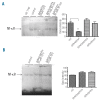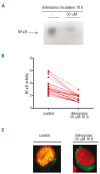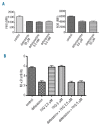Deferasirox is a powerful NF-kappaB inhibitor in myelodysplastic cells and in leukemia cell lines acting independently from cell iron deprivation by chelation and reactive oxygen species scavenging
- PMID: 20534700
- PMCID: PMC2913079
- DOI: 10.3324/haematol.2009.016824
Deferasirox is a powerful NF-kappaB inhibitor in myelodysplastic cells and in leukemia cell lines acting independently from cell iron deprivation by chelation and reactive oxygen species scavenging
Abstract
Background: Usefulness of iron chelation therapy in myelodysplastic patients is still under debate but many authors suggest its possible role in improving survival of low-risk myelodysplastic patients. Several reports have described an unexpected effect of iron chelators, such as an improvement in hemoglobin levels, in patients affected by myelodysplastic syndromes. Furthermore, the novel chelator deferasirox induces a similar improvement more rapidly. Nuclear factor-kappaB is a key regulator of many cellular processes and its impaired activity has been described in different myeloid malignancies including myelodysplastic syndromes.
Design and methods: We evaluated deferasirox activity on nuclear factor-kappaB in myelodysplastic syndromes as a possible mechanism involved in hemoglobin improvement during in vivo treatment. Forty peripheral blood samples collected from myelodysplastic syndrome patients were incubated with 50 muM deferasirox for 18h.
Results: Nuclear factor-kappaB activity dramatically decreased in samples showing high basal activity as well as in cell lines, whereas no similar behavior was observed with other iron chelators despite a similar reduction in reactive oxygen species levels. Additionally, ferric hydroxyquinoline incubation did not decrease deferasirox activity in K562 cells suggesting the mechanism of action of the drug is independent from cell iron deprivation by chelation. Finally, incubation with both etoposide and deferasirox induced an increase in K562 apoptotic rate.
Conclusions: Nuclear factor-kappaB inhibition by deferasirox is not seen from other chelators and is iron and reactive oxygen species scavenging independent. This could explain the hemoglobin improvement after in vivo treatment, such that our hypothesis needs to be validated in further prospective studies.
Figures





References
-
- Aul C, Bowen DT, Yoshida Y. Pathogenesis, etiology and epidemiology of myelodysplastic syndromes. Haematologica. 1998;83(1):71–86. - PubMed
-
- Greenberg P, Cox C, LeBeau MM, Fenaux P, Morel P, Sanz G, et al. International scoring system for evaluating prognosis in myelodysplastic syndromes. Blood. 1997;89(6):2079–88. - PubMed
-
- Malcovati L, Porta MG, Pascutto C, Invernizzi R, Boni M, Travaglino E, et al. Prognostic factors and life expectancy in myelodysplastic syndromes classified according to WHO criteria: a basis for clinical decision making. J Clin Oncol. 2005;23(30):7594–603. - PubMed
-
- Malcovati L, Germing U, Kuendgen A, Della Porta MG, Pascutto C, Invernizzi R, et al. Time-dependent prognostic scoring system for predicting survival and leukemic evolution in myelodysplastic syndromes. J Clin Oncol. 2007;25(23):3503–10. - PubMed
-
- Leitch HA. Improving clinical outcome in patients with myelodysplastic syndrome and iron overload using iron chelation therapy. Leuk Res. 2007;31S3:S7–9. - PubMed
Publication types
MeSH terms
Substances
LinkOut - more resources
Full Text Sources
Medical

